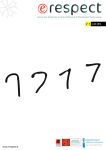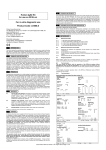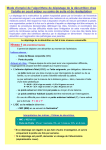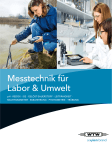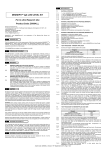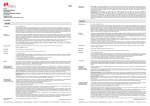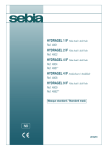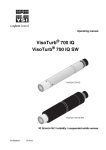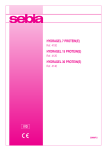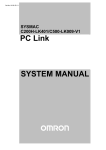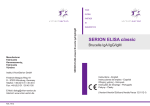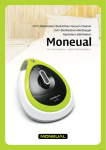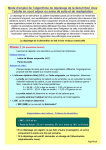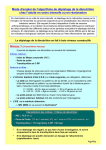Download HUMAN IgG SUBCLASS LIQUID REAGENT KITS (for use on the
Transcript
HUMAN IgG SUBCLASS LIQUID REAGENT KITS (for use on the Siemens BN ProSpec® Analyser*) For in-vitro diagnostic use Product code: LK001.P, NK006.P, NK007.P, LK008.P, LK009.P Product manufactured by: The Binding Site Group Ltd, PO Box 11712, Birmingham B14 4ZB, U.K. www.bindingsite.co.uk Telephone : +44 (0)121 436 1000 Fax : +44 (0)121 430 7061 e-mail: [email protected] *BN ProSpec® is a registered trademark of Siemens Healthcare Diagnostics, Inc. 1 INTENDED USE This kit is intended for quantifying human IgG subclasses 1, 2, 3 and 4 immunoglobulins in serum on the BN ProSpec. Measurement of these immunoglobulins aids in the diagnosis of abnormal protein metabolism and the body’s lack of ability to resist infectious agents. 2 SUMMARY AND EXPLANATION In normal adults, IgG constitutes approximately 75% of the total serum immunoglobulin. Within the IgG class, the usual order of concentration of the 4 subclasses is IgG1>IgG2>IgG3>IgG4, but the actual concentration of each may vary markedly between individuals. The four IgG subclasses show considerable differences in their properties, including ability to fix complement, to bind to macrophages and to pass through the placenta. Abnormal levels of one or more subclass may be associated with certain conditions, including anaphylaxis, autoimmune and gut diseases as well as hypo- and hyper-gammaglobulinaemia (ref 1). In particular, reduced production of IgG2 in children may be associated with recurrent infections (ref 2). The subject has been reviewed (refs 3, 4). The BN ProSpec permits fully automatic, rapid quantitative measurement of light scattering reactions for protein determination. 3 PRINCIPLE OF THE ASSAY Nephelometry involves the measurement of light scattered by particles in solution. This can be applied to the measurement of soluble antigen since, in the presence of the appropriate antibody, insoluble immune complexes are formed, which are light-scattering. When the antibody is in excess, the lightscatter is directly proportional to the concentration of antigen. A calibration curve is initially prepared using a series of diluted standards of known antigen concentration. Samples of unknown antigen concentration can then be assayed and their concentrations determined using the calibration curve. Latex-enhanced Antibodies Some antigen-antibody reactions do not form sufficiently large immune complexes to be detected nephelometrically. If the antibody is coated onto latex particles of a suitable size, the light scattering ability of the immune complexes formed with antigen is enhanced sufficiently to enable nephelometric detection. 4 REAGENTS 4.1 Human IgG1/ IgG2 antisera. These are monospecific for the relevant subclass and are supplied in stabilised liquid form. They contain 0.099% sodium azide, 0.1% E-amino-ncaproic acid (EACA), 0.5% BSA and 0.01% benzamidine as preservatives. 4.2 Human IgG3 / IgG4 reagent. These are monospecific for the relevant subclass and are supplied in stabilised liquid form. They contain 0.033% sodium azide, 0.05% ProClin™*, 0.1% EACA and 0.01% benzamidine as preservatives. 4.3 Calibrators and controls. These consist of pooled human serum and are supplied in stabilised liquid form. They contain 0.099% sodium azide, 0.1% EACA and 0.01% benzamidine as preservatives. The concentration of IgG subclasses given on the vial label has been obtained by comparison with the CRM470 international reference material (ref.5). 4.4 Supplementary reagent. Contains 0.099% sodium azide as a preservative. *ProClin™ is a trademark of Rohm and Haas Corp., Philadelphia, PA. 5 CAUTION All donors of human serum supplied in this kit have been serum tested and found negative for hepatitis B surface antigen (HBsAg) and antibodies to human immunodeficiency virus (HIV1 and HIV2) and hepatitis C virus. The assays used were either approved by the FDA (USA) or cleared for in vitro diagnostic use in the EU (Directive 98/79/EC, Annex II); however, these tests cannot guarantee the absence of infective agents. Proper handling and disposal methods should be established as for all potentially infective material, including (but not limited to) users wearing suitable protective equipment and clothing at all times. Only personnel fully trained in such methods should be permitted to perform these procedures. WARNING: This product contains sodium azide and ProClin 300 and must be handled with caution; suitable gloves and other protective clothing should be worn at all times when handling this product. Do not ingest or allow contact with the skin (particularly broken skin or open wounds) or mucous membranes. If contact does occur wash with a large volume of water and seek urgent medical advice. Explosive metal azides may be formed on prolonged contact of sodium azide with lead and copper plumbing; on disposal of reagent, flush with a large volume of water to prevent azide build up. This product should only be used by suitably trained personnel for the purposes stated in the Intended Use. Strict adherence to these instructions is essential at all times. Results are likely to be invalid if parameters other than those stated in these instructions are used. Reagents from different batch numbers of kits are NOT interchangeable. If large numbers of tests are performed care should be taken to ensure that all the reagents are from the same batch. 6 they are stable for four weeks at 2-8ºC, providing precautions to prevent evaporation and contamination are taken. Open vials should not be left on the analyser when they are not in use. Over time unopened vials of antisera can develop a precipitate or turbidity which is not caused by microbial contamination and does not affect the activity of the antisera. In such cases the antiserum should be clarified by filtration through a disposable filter, pore size 0.2µm or by centrifugation (10mins at approximately 15,000 x g). 7 SPECIMEN COLLECTION AND PREPARATION Use fresh or deep frozen serum samples. Blood samples should be collected by venepuncture, allowed to clot naturally and the serum separated as soon as possible to prevent haemolysis. The serum may be stored at 2-8C for up to 8 days prior to assay, or for prolonged storage kept undiluted at -20C or below. Repeated freezing and thawing should be avoided. Microbially contaminated, haemolysed and lipaemic serum and samples containing particulate matter should not be used. 8 METHODOLOGY 8.1 Materials provided, code: LK001.P kit 8.1.1 8.1.2 8.1.3 8.1.4 8.1.5 8.1.6 8.1.7 8.1.8 2 x 1mL BS IgG Sub Std (Human IgG Subclass Standard) 2 x 1mL BS IgG Sub Low Control (Human IgG Subclass Low Control) 2 x 1mL BS IgG Sub Control (Human IgG Subclass High Control) 1 x 1.6mL Human IgG1 BS Antiserum (Antiserum to IgG1) 1 x 1.6mL Human IgG2 BS Antiserum (Antiserum to IgG2) 1 x 2.4mL IgG3 BS Latex (Latex to IgG3) 1 x 2.4mL IgG4 BS Latex (Latex to IgG4) 1 x 3mL BS Supplementary Reagent L (for IgG3 and IgG4 assay) 8.2 Code: NK006.P, NK007.P, LK008.P and LK009.P kits 8.2.1 8.2.2 8.2.3 8.2.4 8.2.5 2 x 1mL BS IgG Sub Std (Human IgG Subclass Standard) 2 x 1mL BS IgG Sub Low Control (Human IgG Subclass Low Control) 2 x 1mL BS IgG Sub Control (Human IgG Subclass High Control) 4 x 1.6mL antiserum or 4 x 2.4mL Latex Reagent to the appropriate subclass 2 x 3.0mL BS Supplementary Reagent L in LK008.P and LK009.P kits only 8.3 Materials required but not provided 8.3.1 8.3.2 Equipment for collection and preparation of test samples. A fully operational and equipped Analyser. 8.4 Test procedure 8.4.1 The user should be familiar with the operation of the BN ProSpec analyser before attempting to carry out the test procedures. Prepare the analyser as per the user’s manual. The IgG subclass assay protocols are defined in the analyser. A Siemens representative is required to create the new assay protocols. 8.4.2 8.4.3 8.4.4 IgG1 Assay-Details Assay-ID: 201 Name: G1 long name: TBS IgG1 Version: 100 Assayclass: Neph Assaygroup: Serum Result unit: mg/L Sample dilution: 1:100 Min. dilution: 1:5 Evaluation: Measurement duration [1/10 sec.]: 3600 Measurement transfer: 2 Evaluation method: 8 - Two point (BNII) Meas window [1/10 sec.] from: 75 until: 3600 Blockmode: 0 Overflow: 0 Calibration: Calibration method: LogitLog Calibrator: 1306 - IgG Std Deviation[%]: 5% Start dilution: 1:10 Cal valid until: 100 Supporting points: 6 Special parameters: Parameter 1: 2 Controls: Control ID Name Dilution Deviation[%] Level 0776 TBS IgG Sc.1 1:100 15 Medium 0975 TBS IgG Sc.2 1:100 15 Low Transfers: 1 Mixing: No mixing Incubation time[1/10sec.]: 0 Medium 1: Type: SystemLiquid Syringe profile: 7 Medium 2: Type: SystemLiquid Syringe profile: 2 Medium 3: Type: Sample Syringe profile: 3 Medium 4: Type: Destination Syringe profile: 3 Transfers: 2 Mixing: normal Incubation time[1/10sec.]: 0 Medium 1: Type: SystemLiquid Syringe profile: 7 Medium 2: Type: SystemLiquid Syringe profile: 2 Medium 3: Type: Reagent Syringe profile: 3 Medium 4: Type: Destination Syringe profile: 6 Start wash: 06 - goto waste Incubation delta [1/10sec.]: 0 End wash: 00 - normal Medium ID: Buffer Volume[l]: 170 Medium ID: Air Bubble Volume[l]: 2 Medium ID: Volume[l]: 20 No Calib Medium ID: Volume[l]: -92 Start wash: 06 - goto waste Incubation delta [1/10sec.]: 0 End wash: 06 - park needle Medium ID: Buffer Volume[l]: 170 Medium ID: Air Bubble Volume[l]: 2 Medium ID: 1301 - G1 Volume[l]: 40 No Calib Medium ID: Volume[l]: -112 IgG2 Assay-Details Assay-ID: 202 Name: G2 long name: TBS IgG2 Version: 100 Assayclass: Neph Assaygroup: Serum Result unit: mg/L Sample dilution: 1:20 Min. dilution: 1:5 Evaluation: Measurement duration [1/10 sec.]: 3600 Measurement transfer: 2 Evaluation method: 8 - Two point (BNII) Meas window [1/10 sec.] from: 75 until: 3600 Blockmode: 0 Overflow: 0 Calibration: Calibration method: LogitLog Calibrator: 1306 - IgG Std Deviation[%]: 5% Start dilution: 1:5 Cal valid until: 100 Supporting points: 6 Special parameters: Parameter 1: 2 Controls: Control ID Name Dilution Deviation[%] Level 0776 TBS IgG Sc.1 1:20 15 Medium 0975 TBS IgG Sc.2 1:20 15 Low STORAGE AND STABILITY The unopened kits should be stored at 2-8ºC, and can be used until the expiry date given on the kit box label. Unopened reagent, calibrators and controls should be stored at 2-8ºC. Once opened, Insert Code: SIN083, Version: 12th August 2010, Page 1 of 10 Transfers: 1 Mixing: No mixing Incubation time[1/10sec.]: 0 Medium 1: Type: SystemLiquid Syringe profile: 7 Medium 2: Type: SystemLiquid Syringe profile: 2 Medium 3: Type: Sample Syringe profile: 3 Medium 4: Type: Destination Syringe profile: 3 Start wash: 06 - goto waste Incubation delta [1/10sec.]: 0 End wash: 00 - normal Medium ID: Buffer Volume[l]: 170 Medium ID: Air Bubble Volume[l]: 2 Medium ID: Volume[l]: 15 No Calib Medium ID: Volume[l]: -87 Transfers: 2 Mixing: normal Incubation time[1/10sec.]: 0 Medium 1: Type: SystemLiquid Syringe profile: 7 Medium 2: Type: SystemLiquid Syringe profile: 2 Medium 3: Type: Reagent Syringe profile: 3 Medium 4: Type: Destination Syringe profile: 6 8.5 Transfers: 2 Mixing: normal Incubation time[1/10sec.]: 0 Medium 1: Type: SystemLiquid Syringe profile: 7 Medium 2: Type: SystemLiquid Syringe profile: 2 Medium 3: Type: Reagent Syringe profile: 3 Medium 4: Type: Destination Syringe profile: 6 Start wash: 06 - goto waste Incubation delta [1/10sec.]: 0 End wash: 06 - park needle Medium ID: 1302 - G2 Volume[l]: 40 9 No Calib Medium ID: Volume[l]: -112 Assay-Details Assay-ID: 203 Name: G3L long name: TBS LIgG3 Version: 100 Assayclass: Neph Assaygroup: Serum Result unit: mg/L Sample dilution: 1:100 Min. dilution: 1:5 Evaluation: Measurement duration [1/10 sec.]: 3600 Measurement transfer: 2 Evaluation method: 8 - Two point (BNII) Meas window [1/10 sec.] from: 75 until: 3600 Blockmode: 0 Overflow: 0 Calibration: Calibration method: LogitLog Calibrator: 1306 - IgG Std Deviation[%]: 5% Start dilution: 1:80 Cal valid until: 100 Supporting points: 5 Special parameters: Parameter 1: 2 Controls: Control ID Name Dilution Deviation[%] Level 0776 TBS IgG Sc.1 1:100 15 Medium 0975 TBS IgG Sc.2 1:100 15 Low Transfers: 1 Mixing: No mixing Incubation time[1/10sec.]: 0 Medium 1: Type: SystemLiquid Syringe profile: 7 Medium 2: Type: Reagent Syringe profile: 2 Medium 3: Type: Sample Syringe profile: 3 Medium 4: Type: Destination Syringe profile: 3 Transfers: 2 Mixing: normal Incubation time[1/10sec.]: 0 Medium 1: Type: SystemLiquid Syringe profile: 7 Medium 2: Type: SystemLiquid Syringe profile: 2 Medium 3: Type: Reagent Syringe profile: 3 Medium 4: Type: Destination Syringe profile: 6 Start wash: 06 - goto waste Incubation delta [1/10sec.]: 0 End wash: 00 - normal Medium ID: 1304 - G4L Volume[l]: 50 No Calib Medium ID: Volume[l]: -112 Approx. sensitivity mg/L Sample dilution 131 1/5 153 1/5 2.7 1/5 1.9 1/5 INTERPRETATION OF DATA LIMITATIONS 10.1 Nephelometric IgG Subclass assays have been shown to correlate well versus Binding Site Single Dilution RID assays with a wide range of samples. 10.2 These kits are not suitable for the measurement of samples containing rheumatoid factor, paraproteins, other circulating immune complexes (CIC`s) or for lipaemic or haemolysed samples due to the unpredictable degree of non-specific scatter these sample types may generate. Unexpected results should be confirmed using an alternative assay method. 10.3 Customers are strongly recommended to run both controls with every batch of samples being assayed, Should a control value be out of range against a stored curve, it is recommended that the assay be recalibrated. Where control values fall outside ±15% limits against new calibration curves check the instument before repeating the assay. If problems persist, refer to the supplier. 10.4 The results obtained from measuring IgG subclasses should not be used in assessing atopy in allergic patients. 10.5 Diagnosis cannot be made and treatment must not be initiated on the basis of IgG subclass measurements alone. Clinical history and other laboratory findings must also be taken into account. 11 EXPECTED VALUES Medium ID: Diluens Volume[l]: 160 The ranges provided below have been obtained from a limited number of British samples and are intended for guidance purposes only. Wherever possible it is strongly recommended that local ranges are generated. Medium ID: 1305 - SRL Volume[l]: 10 11.1 Medium ID: Volume[l]: 20 No Calib Medium ID: Volume[l]: -90 Start wash: 06 - goto waste Incubation delta [1/10sec.]: 0 End wash: 06 - park needle No Calib Medium ID: Volume[l]: -112 Assay-Details Assay-ID: 204 Name: G4L long name: TBS LIgG4 Version: 100 Assayclass: Neph Assaygroup: Serum Result unit: mg/L Sample dilution: 1:100 Min. dilution: 1:5 Evaluation: Measurement duration [1/10 sec.]: 3600 Measurement transfer: 2 Evaluation method: 8 - Two point (BNII) Meas window [1/10 sec.] from: 75 until: 3600 Blockmode: 0 Overflow: 0 Calibration: Calibration method: LogitLog Calibrator: 1306 - IgG Std Deviation[%]: 5% Start dilution: 1:80 Cal valid until: 100 Supporting points: 5 Special parameters: Parameter 1: 2 Controls: Control ID Name Dilution Deviation[%] Level 0776 TBS IgG Sc.1 1:100 15 Medium 0975 TBS IgG Sc.2 1:100 15 Low Start wash: 06 - goto waste Incubation delta [1/10sec.]: 0 End wash: 00 - normal Medium ID: Diluens Volume[l]: 160 Medium ID: 1305 - SRL Volume[l]: 10 Medium ID: Volume[l]: 20 Medium ID: Volume[l]: -90 IgG Subclass IgG1 IgG2 IgG3 IgG4 Number (n) 30 30 30 30 Mean (mg/L) 6330 4528 790.7 280.0 Median (mg/L) 6085 4541 706.4 215.3 95 Percentile Range (mg/L) 3824 – 9286 2418 – 7003 218.2 –1760.6 39.2 – 864.0 Paediatric ranges These ranges were obtained by measuring the Total IgG and subclass content of paediatric serum samples from a Birmingham Hospital using Binding Site Radial Immunodiffusion products. All concentrations are in mg/L. Medium ID: Air Bubble Volume[l]: 2 Medium ID: 1303 - G3L Volume[l]: 50 Adult normal ranges These ranges were obtained by measuring the subclass content of sera provided by the Birmingham Blood Transfusion Service taken from healthy adult donors. 11.2 Medium ID: Diluens Volume[l]: 160 IgG4 Transfers: 1 Mixing: No mixing Incubation time[1/10sec.]: 0 Medium 1: Type: SystemLiquid Syringe profile: 7 Medium 2: Type: Reagent Syringe profile: 2 Medium 3: Type: Sample Syringe profile: 3 Medium 4: Type: Destination Syringe profile: 3 Medium ID: Air Bubble Volume[l]: 2 Quality Control: The IgG subclass concentration assigned to the controls are given on the bottle labels. Results obtained during the run should only be accepted if they are within ±15% of the value(s) stated. 10 IgG3 Medium ID: Diluens Volume[l]: 160 Approx. measuring range mg/L Sample dilution 2625-84000 1/100 613-19600 1/20 55 – 875 1/100 38 - 613 1/100 IgG1 IgG2 IgG3 IgG4 Medium ID: Air Bubble Volume[l]: 2 End wash: 06 - park needle Measuring range and sensitivity Specificity Medium ID: Buffer Volume[l]: 170 Start wash: 06 - goto waste Incubation delta [1/10sec.]: 0 No Calib 0-2 years IgG1 IgG2 IgG3 IgG4 Total IgG 2-4 years IgG1 IgG2 IgG3 IgG4 Total IgG 4-6 years IgG1 IgG2 IgG3 IgG4 Total IgG 6-8 years IgG1 IgG2 IgG3 IgG4 Total IgG 8-10 years IgG1 IgG2 IgG3 IgG4 Total IgG 10-12 years IgG1 IgG2 IgG3 IgG4 Total IgG 12-14 years IgG1 IgG2 IgG3 IgG4 Total IgG N 39 39 39 39 39 Mean 5248 838 445 129 6640 95%ile Range 1940 – 8420 225 – 3000 186 – 853 5 – 784 3270 – 12700 36 36 36 36 36 5495 1146 396 171 7770 3150 – 9450 360 – 2250 173 – 676 10 – 537 4680 – 12500 49 49 49 49 49 6149 1496 531 329 9280 3060 – 9450 605 – 3450 99 – 1221 18 – 1125 5320 - 13400 43 43 43 43 43 5758 1754 437 331 8860 2880 – 9180 440 – 3750 155 – 853 4 – 992 4540 – 13600 32 32 32 32 32 6345 2126 521 349 9700 4320 – 10200 720 – 4300 127 – 853 19 – 932 5680 - 13600 46 46 46 46 46 6421 1980 620 323 10200 4230 – 10600 760 – 3550 173 – 1730 16 – 1150 5680 - 14900 54 54 54 54 54 6581 2486 583 409 10500 3420 – 11500 1000 – 4550 283 – 1250 37 – 1360 6640 – 14900 Insert Code: SIN083, Version: 12th August 2010, Page 2 of 10 14-18 years IgG1 IgG2 IgG3 IgG4 Total IgG 12 48 48 48 48 48 6057 2614 708 521 10100 3150 – 8550 640 – 4950 230 –1960 110 – 1570 5500 – 14400 IgG SUBKLASSEN (HUMAN) KIT (zur Verwendung auf dem Siemens BN ProSpec®) PERFORMANCE CHARACTERISTICS The performance characteristics shown here is data generated on a Siemens BNTMII*, which is an analyser that performs in the same way as the BN ProSpec. 12.1 Nur zur in-vitro Diagnostik Within-run precision Three serum preparations, containing different levels of IgG subclasses, were assayed 10 times. All concentrations are in mg/L. Serum 1 Serum 2 Serum 3 12.2 IgG1 Mean CV % 40529 1.56 12630 1.67 3350 6.44 IgG2 Mean CV % 8256 2.59 1736 2.16 758.5 8.19 IgG3 Mean CV % 668.6 2.74 517.8 2.76 353.1 3.49 IgG4 Mean CV % 534.1 3.05 396.1 2.95 324.8 5.08 Between-run precision Three serum preparations containing different levels of IgG subclasses were assayed on at least three separate occasions. All concentrations are in mg/L. (N) = number of runs. IgG1 IgG2 IgG3 CV % CV % CV % Mean Mean (N) (N) (N) 4.38 6.84 4.41 Serum 1 40765 7811 697.5 (6) (6) (3) 2.39 4.18 2.38 Serum 2 12402 1621 525.9 (6) (6) (4) 6.95 2.43 3.00 Serum 3 3043 780.1 353.1 (6) (6) (3) *BN™ is a trademark of Siemens Healthcare Diagnostics Inc. Mean 13 1. 2. 3. 4. 5. IgG4 CV % (N) 4.10 532.6 (3) 4.13 387.7 (3) 4.38 319.6 (4) Mean Bestell-Nr.: LK001.P, NK006.P, NK007.P, LK008.P, LK009.P Hergestellt von: The Binding Site Group Ltd, PO Box 11712, Birmingham, B14 4ZB, UK. www.bindingsite.co .uk Vertrieb in Deutschland und Österreich durch: The Binding Site GmbH, Robert-Bosch-Straβe 2A, D-68723 Schwetzingen, Deutschland Telefon: +49 (0)6202 92 62 0 Fax: +49 (0)6202 92 62 222 e-mail: [email protected] BN ProSpec® ist ein eingetragenes Warenzeichen von Siemens Healthcare Diagnostics, Inc. 1 BIBLIOGRAPHY Shakib, F & Stanworth D R (1980). Human IgG subclasses in health and disease (Part II). La Ricerca Clin. Lab. 10, 561-580. Shackleford, P G, Polmar, S H et al. (1986). Spectrum of IgG2 subclass deficiency in children with recurrent infections: Prospective study. J. Pediatr. 108, 647-653. Hamilton, R H (1987), Human IgG subclass measurements in the clinical laboratory. Clin. Chem. 33, 1707-1725. Schur, P H (1987), IgG subclasses – a review. Annals of Allergy 58, 89-99 Carr-Smith, H.D, Overton, J, Bradwell, A.R. (1997). IgG subclass value assignment to the protein reference preparation CRM470. Clin. Chem. Vol. 43, No 56, PS238. VERWENDUNGSZWECK Zur quantitativen Bestimmung von Human IgG Subklassen 1, 2, 3 und 4 im Serum auf dem BN ProSpec. Die Bestimmung dieser Immunglobuline dient zur Unterstützung der Diagnose eines abnormalen Proteinmetabolismus und das Unvermögen des Körpers auf infektiöse Erreger zu reagieren. 2 EINLEITUNG Bei gesunden Erwachsenen stellt IgG ca. 75% des Gesamtimmunglobulins dar. Innerhalb der IgGKlasse nimmt die Konzentration in der Reihenfolge IgG1 > IgG2 > IgG3 > IgG4 ab, wobei der tatsächliche Gehalt individuell deutlich variieren kann. Die vier IgG Subklassen zeigen deutliche Unterschiede in ihren Eigenschaften, wie z.B. Fähigkeit zur Komplementbindung, Makrophagenbindung und Placentadurchlässigkeit. Von der Norm abweichende Werte einer oder mehrerer Subklassen können mit verschiedenen Erkrankungen in Verbindung gebracht werden, z. B. Autoimmunerkrankungen, Anaphylaxie, Darmerkrankungen, sowie Hypo- und Hypergammaglobulinämien (Ref. 1). Speziell bei Kindern kann sich eine verminderte IgG2-Produktion durch wiederkehrende Infektionen bemerkbar machen (Ref. 2; Reviews: Ref. 3, 4). Das BN ProSpec erlaubt eine vollautomatische, schnelle und quantitative Bestimmung der Präzipitationsreaktion zur Proteinbestimmung. 3 TESTPRINZIP Die Nephelometrie beruht auf der Messung von Streulicht, das durch lösliche Partikel in einer Lösung erzeugt wird. Dieses Prinzip kann für die Messung von löslichen Antigenen angewendet werden, da sie mit dem entsprechenden spezifischen Antikörper reagieren und einen unlöslichen Antigen-Antikörper-Komplex (Immunkomplex) bilden. Diese Immunkomplexe streuen in die Lösung eingestrahltes Licht und wenn der Antikörper im Überschuss vorliegt, ist die Lichtstreuung direkt proportional zur Antigenkonzentration. Durch Messung eines verschieden verdünnten Standards mit bekannter Antigenkonzentration wird eine Kalibrationskurve erstellt. Die Antigenkonzentration von unbekannten Proben wird nach Messung direkt an Hand der Kalibrationskurve ermittelt. Latex-verstärkte Antikörper: Bei einigen Antigen-Antikörper-Reaktionen werden nicht genügend große Immunkomplexe gebildet und diese können daher nicht nephelometrisch bestimmt werden. Ist der Antikörper an ein Latexpartikel mit geeigneter Größe gekoppelt, kann der so geformte Immunkomplex ausreichend Licht streuen. Jetzt ist das Antigen der nephelometrischen Bestimmung zugänglich. 4 REAGENZIEN 4.1 Human IgG1-/IgG2-Antiserum. Diese Antiseren sind monospezifisch für die jeweilige Subklasse und liegen als stabilisierte Flüssigkeit vor. Enthaltene Konservierungsmittel: 0,099% Natriumazid, 0,1% E-aminocapronsäure (EACA), 0,5% BSA und 0,01% Benzamidin. 4.2 Human IgG3-/ IgG4-Latex-Reagenz. Diese Latex-Reagenzien sind monospezifisch für die jeweilige Subklasse und liegen als stabilisierte Flüssigkeit vor. Enthaltene Konservierungsmittel: 0,033% Natriumazid, 0,05% ProClin™*, 0,1% EACA und 0,01% Benzamidin. 4.3 Kalibratoren und Kontrollen. Sie werden aus gepooltem Humanserum hergestellt und liegen als stabilisierte Flüssigkeiten vor. Enthaltene Konservierungsmittel: 0,099% Natriumazid, 0,1% (EACA) und 0,01% Benzamidin. Der Wert von IgG Subklassen wurde durch Vergleich mit dem internationalen CRM470-Referenzmaterial ermittelt (Ref. 5) 4.4 B.S. Zusatzreagenz. Enthaltene Konservierungsmittel: 0,099% Natriumazid. ProClin™ ist ein Warenzeichen von Rohm and Haas Corp., Philadelphia, PA. 5 WARNUNGEN UND VORSICHTSMAßNAHMEN Jede Einzelspende von humanem Serum wurde untersucht und bezüglich Antikörper gegen das Human-Immunschwäche-Virus (HIV 1 & 2), das Hepatitis-C-Virus und gegen das Hepatitis-B-Oberflächenantigen (HBsAG) als negativ befunden. Die hierfür verwendeten Tests sind für den Gebrauch in der in vitro Diagnostik in der EU freigegeben (Directive 98/79/EC, Annex II). Es gibt aber zur Zeit keine absolut sicheren Testmethoden zum Auschluss dieser und anderer Infektionsträger. Umgangs- und Entsorgungsmethoden sollten denen für potentiell infektiösem Material entsprechen (inklusive dem Tragen entsprechender Schutzkleidung). Der Test sollte nur von entsprechend geschultem Personal durchgeführt werden. ACHTUNG: Dieses Produkt enthält Natriumazid und ProClin 300 und muss mit den entsprechenden Vorsichts-maßnahmen behandelt werden. Das Tragen von Handschuhen und anderer Schutzkleidung wird während des Umgangs mit diesem Produkt empfohlen. Verschlucken sowie Kontakt mit Haut (v.a. bei Verletzungen) oder Schleimhäuten vermeiden. Nach Kontakt Hautstelle mit viel Wasser abspülen und ärztlichen Rat einholen. Natriumazid kann mit Blei- oder Kupferrohren explosive Metallazide bilden. Nach der Entsorgung mit ausreichender Menge Wasser, nachspülen um Azidablagerungen zu vermeiden. Dieser Test sollte nur für den angegebenen Verwendungszeck von entsprechend geschultem Laborpersonal durchgeführt werden. Die Einhaltung der Arbeitsanleitung bei allen Arbeitsschritten ist dringend notwendig. Bei Verwendung von abgeänderten Testparametern kann die Richtigkeit der Ergebnisse nicht garantiert werden. Insert Code: SIN083, Version: 12th August 2010, Page 3 of 10 Reagenzien unterschiedlicher Chargen dürfen NICHT untereinander gemischt oder gemeinsam verwendet werden. Bei großem Testdurchsatz muss darauf geachtet werden, dass alle Reagenzien der gleichen Charge entstammen. 6 LAGERUNG UND STABILITÄT Die ungeöffneten Kits sind bei 2-8°C bis zum auf dem Außenetikett angegebenen Verfallsdatum haltbar. Ungeöffnete Reagenzien, Kalibratoren und Kontrollen bei 2-8°C lagern. Nach dem Öffnen sind sie 4 Wochen bei 2-8°C stabil. Reagenzien so lagern, dass keine Verdunstung oder Verunreinigung stattfinden kann. Offene Flaschen nach Gebrauch nicht im Gerät stehen lassen. Während der Lagerung kann in den noch ungeöffneten Antiseren ein Niederschlag oder eine Trubüng entstehen. Dies wird nicht durch mikrobielle Kontamination verursacht und beeinflusst die Aktivität des Antiserums nicht. In solchen Fällen das Antiserum durch Filtration durch einen EinwegFilter mit der Porengröe von 0,2 µm oder Zentrifugation (ca. 10 min. bei 15000g) klaren. 7 PROBENENTNAHME UND –VORBEREITUNG Immer frisches oder tiefgefrorenes Serum verwenden. Blutproben über Venenpunktur sammeln und auf natürliche Weise gerinnen lassen. Serum so schnell wie möglich vom Gerinnsel trennen um eine Hämolyse zu vermeiden. Die Seren können bei 2-8C bis zu 8 Tagen vor dem Test gelagert werden. Für eine längere Lagerung empfiehlt es sich, die Seren unverdünnt bei mindestens -20C einzufrieren. Wiederholtes Einfrieren und Auftauen vermeiden. Keine mikrobiell oder mit Partikeln verunreinigte Seren, oder hämolytische oder lipämische Seren verwenden. 8 TESTDURCHFÜHRUNG 8.1 Gelieferte Materialien für Kombi-Kit, Bestell-Nr. LK001.P 8.1.1 8.1.2 8.1.3 8.1.4 8.1.5 8.1.6 8.1.7 8.1.8 2 x 1mL BS IgG Sub Std (Human IgG-Subklassen-Kalibrator) 2 x 1mL BS IgG Sub Low Control (Human IgG-Subklassen-Kontrolle ‘Low Level’) 2 x 1mL BS IgG Sub Control (Human IgG-Subklassen-Kontrolle ’High Level’) 1 x 1,6mL Human IgG1 BS Antiserum (IgG1-Subklassen-Antiserum) 1 x 1,6mL Human IgG2 BS Antiserum (IgG2-Subklassen-Antiserum) 1 x 2,4mL IgG3 BS Latex (IgG3-Latex-Reagenz) 1 x 2,4mL IgG4 BS Latex (IgG4-Latex-Reagenz) 1 x 3mL BS Supplementary Reagent L (BS Supplementary Reagent L für die IgG3- und IgG4-Tests. 8.2 Bestell-Nr.: NK006.P, NK007.P, LK008.P, LK009.P 8.2.1 8.2.2 8.2.3 8.2.4 8.2.5 2 x 1mL BS IgG Sub Std (Human IgG-Subklassen-Kalibrator) 2 x 1mL BS IgG Sub Low Control (Human IgG Subklassen Kontrolle ‘Low Level’) 2 x 1mL BS IgG Sub Control (Human IgG Subklassen Kontrolle ’High Level’) 4 x 1,6mL Antiserum oder 4 x 2,4mL Latexreagenz der jeweiligen-Subklasse 2 x 3mL BS Supplementary Reagent L (nur für LK008.P und LK009.P) 8.3 Benötigte, nicht im Kit enthaltene Materialien 8.3.1 8.3.2 Laborausstattung zum Sammeln und Vorbereiten der Proben (Probenröhrchen, Zentrifugen etc.) Einen voll ausgestatteten und funktionsfähigen BN ProSpec 8.4 Testdurchführung 8.4.1 8.4.2 8.4.3 8.4.4 Der Anwender sollte mit dem BN ProSpec vertraut sein, bevor der Test durchgeführt wird. Das Gerät wie im Handbuch des Herstellers beschrieben vorbereiten. Die IgG-Subklassen-Testparameter werden im Gerät angelegt. Für die Programmierung neuer Testparameter ist ein Siemens Mitarbeiter erforderlich. IgG1 Assay-Details Assay-ID: 201 Name: G1 long name: TBS IgG1 Version: 100 Assayclass: Neph Assaygroup: Serum Result unit: mg/L Sample dilution: 1:100 Min. dilution: 1:5 Evaluation: Measurement duration [1/10 sec.]: 3600 Measurement transfer: 2 Evaluation method: 8 - Two point (BNII) Meas window [1/10 sec.] from: 75 until: 3600 Blockmode: 0 Overflow: 0 Calibration: Calibration method: LogitLog Calibrator: 1306 - IgG Std Deviation[%]: 5% Start dilution: 1:10 Cal valid until: 100 Supporting points: 6 Special parameters: Parameter 1: 2 Controls: Control ID Name Dilution Deviation[%] Level 0776 TBS IgG Sc.1 1:100 15 Medium 0975 TBS IgG Sc.2 1:100 15 Low Transfers: 1 Mixing: No mixing Incubation time[1/10sec.]: 0 Medium 1: Type: SystemLiquid Syringe profile: 7 Medium 2: Type: SystemLiquid Syringe profile: 2 Medium 3: Type: Sample Syringe profile: 3 Medium 4: Type: Destination Syringe profile: 3 Transfers: 2 Mixing: normal Incubation time[1/10sec.]: 0 Medium 1: Type: SystemLiquid Syringe profile: 7 Medium 2: Type: SystemLiquid Syringe profile: 2 Medium 3: Type: Reagent Syringe profile: 3 Medium 4: Type: Destination Syringe profile: 6 Start wash: 06 - goto waste Incubation delta [1/10sec.]: 0 End wash: 00 - normal Medium ID: Buffer Volume[l]: 170 Medium ID: Air Bubble Volume[l]: 2 Medium ID: Volume[l]: 20 No Calib Medium ID: Volume[l]: -92 Start wash: 06 - goto waste Incubation delta [1/10sec.]: 0 End wash: 06 - park needle IgG2 Assay-Details Assay-ID: 202 Name: G2 long name: TBS IgG2 Version: 100 Assayclass: Neph Assaygroup: Serum Result unit: mg/L Sample dilution: 1:20 Min. dilution: 1:5 Evaluation: Measurement duration [1/10 sec.]: 3600 Measurement transfer: 2 Evaluation method: 8 - Two point (BNII) Meas window [1/10 sec.] from: 75 until: 3600 Blockmode: 0 Overflow: 0 Calibration: Calibration method: LogitLog Calibrator: 1306 - IgG Std Deviation[%]: 5% Start dilution: 1:5 Cal valid until: 100 Supporting points: 6 Special parameters: Parameter 1: 2 Controls: Control ID Name Dilution Deviation[%] Level 0776 TBS IgG Sc.1 1:20 15 Medium 0975 TBS IgG Sc.2 1:20 15 Low Transfers: 1 Mixing: No mixing Incubation time[1/10sec.]: 0 Medium 1: Type: SystemLiquid Syringe profile: 7 Medium 2: Type: SystemLiquid Syringe profile: 2 Medium 3: Type: Sample Syringe profile: 3 Medium 4: Type: Destination Syringe profile: 3 Transfers: 2 Mixing: normal Incubation time[1/10sec.]: 0 Medium 1: Type: SystemLiquid Syringe profile: 7 Medium 2: Type: SystemLiquid Syringe profile: 2 Medium 3: Type: Reagent Syringe profile: 3 Medium 4: Type: Destination Syringe profile: 6 Start wash: 06 - goto waste Incubation delta [1/10sec.]: 0 End wash: 00 - normal Medium ID: Buffer Volume[l]: 170 Medium ID: Air Bubble Volume[l]: 2 Medium ID: Volume[l]: 15 No Calib Medium ID: Volume[l]: -87 Start wash: 06 - goto waste Incubation delta [1/10sec.]: 0 End wash: 06 - park needle Medium ID: Buffer Volume[l]: 170 Medium ID: Air Bubble Volume[l]: 2 Medium ID: 1302 - G2 Volume[l]: 40 No Calib Medium ID: Volume[l]: -112 IgG3 Assay-Details Assay-ID: 203 Name: G3L long name: TBS LIgG3 Version: 100 Assayclass: Neph Assaygroup: Serum Result unit: mg/L Sample dilution: 1:100 Min. dilution: 1:5 Evaluation: Measurement duration [1/10 sec.]: 3600 Measurement transfer: 2 Evaluation method: 8 - Two point (BNII) Meas window [1/10 sec.] from: 75 until: 3600 Blockmode: 0 Overflow: 0 Calibration: Calibration method: LogitLog Calibrator: 1306 - IgG Std Deviation[%]: 5% Start dilution: 1:80 Cal valid until: 100 Supporting points: 5 Special parameters: Parameter 1: 2 Controls: Control ID Name Dilution Deviation[%] Level 0776 TBS IgG Sc.1 1:100 15 Medium 0975 TBS IgG Sc.2 1:100 15 Low Transfers: 1 Mixing: No mixing Incubation time[1/10sec.]: 0 Medium 1: Type: SystemLiquid Syringe profile: 7 Medium 2: Type: Reagent Syringe profile: 2 Medium 3: Type: Sample Syringe profile: 3 Medium 4: Type: Destination Syringe profile: 3 Transfers: 2 Mixing: normal Incubation time[1/10sec.]: 0 Medium 1: Type: SystemLiquid Syringe profile: 7 Medium 2: Type: SystemLiquid Syringe profile: 2 Medium 3: Type: Reagent Syringe profile: 3 Medium 4: Type: Destination Syringe profile: 6 Start wash: 06 - goto waste Incubation delta [1/10sec.]: 0 End wash: 00 - normal Medium ID: Diluens Volume[l]: 160 Medium ID: 1305 - SRL Volume[l]: 10 Medium ID: Volume[l]: 20 No Calib Medium ID: Volume[l]: -90 Start wash: 06 - goto waste Incubation delta [1/10sec.]: 0 End wash: 06 - park needle Medium ID: Diluens Volume[l]: 160 Medium ID: Air Bubble Volume[l]: 2 Medium ID: 1303 - G3L Volume[l]: 50 No Calib Medium ID: Volume[l]: -112 IgG4 Medium ID: Buffer Volume[l]: 170 Medium ID: Air Bubble Volume[l]: 2 Medium ID: 1301 - G1 Volume[l]: 40 Medium ID: Volume[l]: -112 No Calib Assay-Details Assay-ID: 204 Name: G4L long name: TBS LIgG4 Version: 100 Assayclass: Neph Assaygroup: Serum Result unit: mg/L Sample dilution: 1:100 Min. dilution: 1:5 Evaluation: Measurement duration [1/10 sec.]: 3600 Measurement transfer: 2 Evaluation method: 8 - Two point (BNII) Meas window [1/10 sec.] from: 75 until: 3600 Blockmode: 0 Overflow: 0 Calibration: Calibration method: LogitLog Calibrator: 1306 - IgG Std Deviation[%]: 5% Start dilution: 1:80 Cal valid until: 100 Supporting points: 5 Special parameters: Parameter 1: 2 Controls: Control ID Name Dilution Deviation[%] Level 0776 TBS IgG Sc.1 1:100 15 Medium 0975 TBS IgG Sc.2 1:100 15 Low Insert Code: SIN083, Version: 12th August 2010, Page 4 of 10 Transfers: 1 Mixing: No mixing Incubation time[1/10sec.]: 0 Medium 1: Type: SystemLiquid Syringe profile: 7 Medium 2: Type: Reagent Syringe profile: 2 Medium 3: Type: Sample Syringe profile: 3 Medium 4: Type: Destination Syringe profile: 3 Transfers: 2 Mixing: normal Incubation time[1/10sec.]: 0 Medium 1: Type: SystemLiquid Syringe profile: 7 Medium 2: Type: SystemLiquid Syringe profile: 2 Medium 3: Type: Reagent Syringe profile: 3 Medium 4: Type: Destination Syringe profile: 6 8.5 Start wash: 06 - goto waste Incubation delta [1/10sec.]: 0 End wash: 00 - normal Medium ID: Diluens Volume[l]: 160 Medium ID: 1305 - SRL Volume[l]: 10 No Calib Medium ID: Volume[l]: 20 Medium ID: Volume[l]: -90 Start wash: 06 - goto waste Incubation delta [1/10sec.]: 0 End wash: 06 - park needle Medium ID: Diluens Volume[l]: 160 Medium ID: Air Bubble Volume[l]: 2 Medium ID: 1304 - G4L Volume[l]: 50 12 No Calib 12.1. IgG1 IgG2 IgG3 IgG4 9 Ungefährer Messbereich Probenvermg/L dünnung 2625 - 84000 1/ 100 613 – 19600 1/ 20 55 – 875 1/ 100 38 - 613 1/ 100 6345 2126 521 349 9700 4320 – 10200 720 – 4300 127 – 853 19 – 932 5680 - 13600 46 46 46 46 46 6421 1980 620 323 10200 4230 – 10600 760 – 3550 173 – 1730 16 – 1150 5680 - 14900 54 54 54 54 54 6581 2486 583 409 10500 3420 – 11500 1000 – 4550 283 – 1250 37 – 1360 6640 – 14900 48 48 48 48 48 6057 2614 708 521 10100 3150 – 8550 640 – 4950 230 –1960 110 – 1570 5500 – 14400 LEISTUNGSDATEN Ungefähre Sensitivität Probenverdünnung 131 1/5 153 1/5 2,7 1/5 1,9 1/5 Intra-Assay-Variation Drei Serum-Präparationen mit unterschiedlichen IgG-Subklassen-Konzentrationen wurden 10 mal gemessen. Alle Konzentrationsangaben sind in mg/L. mg/L Serum 1 Serum 2 Serum 3 12.2 INTERPRETATION DER ERGEBNISSE Qualitätskontrolle: Die IgG-Subklassen-Konzentrationen der Kontrollen sind auf dem jeweiligen Flaschenetikett angegeben. Der von dem BN ProSpec gemessene Wert sollte maximal 15 % vom angegebenen Wert abweichen. 10 32 32 32 32 32 Die unten aufgeführten Leistungsdaten wurden auf einem Siemens BN™II* ermittelt, der nach dem gleichen Prinzip wie der BN ProSpec arbeitet, ermittelt. Medium ID: Volume[l]: -112 Messbereich und Sensitivität Spezifität 8-10 Jahre IgG1 IgG2 IgG3 IgG4 Total IgG 10-12 Jahre IgG1 IgG2 IgG3 IgG4 Total IgG 12-14 Jahre IgG1 IgG2 IgG3 IgG4 Total IgG 14-18 Jahre IgG1 IgG2 IgG3 IgG4 Total IgG IgG1 Mittelwert 40529 12630 3350 % VK 1.56 1.67 6.44 10.1 Die nephelometrische Bestimmung der IgG Subklassen korreliert bei einer großen Probenzahl sehr gut zur Binding Site IgG Subklassen Single Dilution RID Methode. 10.2 Dieser Kit ist nicht für die Bestimmung von lipämischen oder hämolysierten Proben, oder Proben, die Rheumafaktoren, Paraproteine oder andere zirkulierende Immunkomplexe enthalten, geeignet, da diese Proben einen nicht vorhersagbaren Anteil an unspezifischen Streulicht erzeugen können. Ungewöhnliche Ergebnisse sollten mit einer alternativen Methode überprüft werden. 10.3 Es wird dringend empfohlen, dass bei jedem Testansatz beide Kontrollen mitgeführt werden. Wird eine gespeicherte Kalibrationskurve verwendet und eine der Kontrollen liegt nicht im Vertrauensbereich, sollte der Test neu kalibriert werden. Weicht die Kontrolle weiterhin mehr als ±15% vom Sollwert ab, sollte vor einer erneuten Testdurchführung das Gerät überprüft werden. Kann das Problem so nicht gelöst werden, wenden Sie sich bitte an ihre Lieferfirma. Die IgG-Subklassen-Ergebnisse sollten nicht zur Diagnose einer Atopie bei AllergiePatienten verwendet werden. 10.5 Die Diagnose und Einleitung einer Therapie dürfen nicht ausschließlich auf der IgGSubklassen-Bestimmung basieren. Das klinische Bild und andere serologische Befunde müssen ebenfalls berücksichtigt werden. 13 1. 2. 4. 5. Shakib, F & Stanworth D R (1980). Human IgG subclasses in health and disease (Part II). La Ricerca Clin. Lab. 10, 561-580. Shackleford, P G, Polmar, S H et al. (1986). Spectrum of IgG2 subclass deficiency in children with recurrent infections: Prospective study. J. Pediatr. 108, 647-653. Hamilton, R H (1987), Human IgG subclass measurements in the clinical laboratory. Clin. Chem. 33, 1707-1725. Schur, P H (1987), IgG subclasses – a review. Annals of Allergy 58, 89-99. Carr-Smith, H.D, Overton, J, Bradwell, A.R. (1997). IgG subclass value assignment to the protein reference preparation CRM470. Clin. Chem. Vol. 43, No 56, PS238. ERWARTETE WERTE Die unten aufgeführten Normalbereiche basieren auf der Untersuchung eines gesunden Blutspenderkollektivs aus Großbritannien mit diesen Kits und dienen nur zur Orientierung. Es wird empfohlen eigene Normalbereiche zu bestimmen. 11.2 Anzahl (n) 30 30 30 30 Mittelwert (mg/L) 6330 4528 790.7 280.0 Median (mg/L) 6085 4541 706.4 215.3 95%lle Bereich (mg/L) 3824 – 9286 2418 – 7003 218.2 –1760.6 39.2 – 864.0 Kinder Diese Werte wurden mittels Radialer Immundiffusion (The Binding Site ‘Single Dilution’) ermittelt. Die Seren der Kinder wurden in einem Krankenhaus von Birmingham (England) gesammelt. Alle Angaben sind in mg/L. 0-2 Jahre IgG1 IgG2 IgG3 IgG4 Total IgG 2-4 Jahre IgG1 IgG2 IgG3 IgG4 Total IgG 4-6 Jahre IgG1 IgG2 IgG3 IgG4 Total IgG 6-8 Jahre IgG1 IgG2 IgG3 IgG4 Total IgG Anzahl 39 39 39 39 39 Mittelwert 5248 838 445 129 6640 95%ile Bereich 1940 – 8420 225 – 3000 186 – 853 5 – 784 3270 – 12700 36 36 36 36 36 5495 1146 396 171 7770 3150 – 9450 360 – 2250 173 – 676 10 – 537 4680 – 12500 49 49 49 49 49 6149 1496 531 329 9280 3060 – 9450 605 – 3450 99 – 1221 18 – 1125 5320 - 13400 43 43 43 43 43 5758 1754 437 331 8860 2880 – 9180 440 – 3750 155 – 853 4 – 992 4540 – 13600 % VK (N) 4.10 (3) 4.13 (3) 4.38 (4) REFERENZEN Erwachsene IgG1 IgG2 IgG3 IgG4 % VK 3.05 2.95 5.08 Inter-Assay-Variation IgG2 IgG3 IgG4 % VK % VK % VK Mittelwert Mittelwert Mittelwert (N) (N) (N) 4.38 6.84 4.41 Serum 1 40765 7811 697.5 532.6 (6) (6) (3) 2.39 4.18 2.38 Serum 2 12402 1621 525.9 387.7 (6) (6) (4) 6.95 2.43 3.00 Serum 3 3043 780.1 353.1 319.6 (6) (6) (3) BNTM ist ein eingetragenes Warenzeichen von Siemens Healthcare Diagnostics, Inc. 3. 10.4 IgG Subklasse IgG4 Mittelwert 534.1 396.1 324.8 IgG1 GRENZEN DES TESTS 11 IgG3 Mittelwert % VK 668.6 2.74 517.8 2.76 353.1 3.49 3 Serum-Präparationen mit unterschiedlichen IgG-Subklassen-Konzentrationen wurden an mindestens 3 verschiedenen Zeitpunkten bestimmt. Alle Konzentrationsangaben sind in mg/L. (N= Anzahl der Zeitpunkte) Mittelwert 11.1 IgG2 Mittelwert % VK 8256 2.59 1736 2.16 758.5 8.19 Insert Code: SIN083, Version: 12th August 2010, Page 5 of 10 6 REACTIFS LIQUIDES POUR LE DOSAGE DES SOUS-CLASSES D’IgG HUMAINES (pour une utilisation sur automate Siemens BN ProSpec®*) Pour un usage en diagnostic in vitro uniquement Référence : LK001.P NK006.P, NK007.P, LK008.P, LK009.P Produit fabriqué en Angleterre par la société : The Binding Site Group Ltd, PO Box 11712, Birmingham B14 4ZB, U.K. www.bindingsite.co.uk Les coffrets non ouverts doivent être conservés entre 2 et 8°C et peuvent être utilisés jusqu’à la date de péremption indiquée sur l’étiquette de la boîte. Les réactifs non ouverts, calibrateurs et contrôles doivent être gardés à 2-8°C. Après ouverture, ils sont stables quatre semaines à 2-8°C s’ils ne sont pas contaminés ou évaporés. Il est recommandé de ne pas laisser les flacons d’antisérum ouverts sur les néphélémètres à température ambiante en dehors de leur utilisation. Au cours du temps, les flacons d'antisérums non ouverts peuvent développer un précipité ou un trouble qui n'est dû à une contamination bacterienne et qui n'affecte pas l'activité de l'antiserum. Dans de telles situations, l'antisérum doit être clarifié par filtration à travers un filtre ayant des pores de 0,2 µm ou par centrifugation (approximativement 10 minutes à 15000g). 7 BN ProSpec® est une marque déposée de Siemens Healthcare Diagnostics, Inc. 1 INDICATIONS Ce coffret est destiné au dosage quantitatif des sous-classes 1, 2, 3 et 4 d’IgG dans le sérum humain par néphélémétrie en utilisant le néphélémètre BN ProSpec de la société Siemens. La mesure de ces immunoglobulines apporte une aide dans le diagnostic du métabolisme anormal des protéines et des problèmes de l’organisme à résister aux agents infectieux. 2 PRESENTATION GENERALE Chez les sujets adultes en bonne santé, l’IgG représente environ 75% de la concentration en Immunoglobulines sériques totales. Dans la classe des IgG, les concentrations de chaque sous classe sont généralement dans l’ordre IgG1>IgG2>IgG3>IgG4, bien que la concentration effective de chaque sous classe puisse varier considérablement selon les individus. Les quatre sous classes d’IgG présentent des différences considérables dans leurs propriétés, incluant la capacité de fixation du complément, de se lier aux macrophages et de passer la barrière placentaire. Des taux inusuels d’une ou plusieurs sous classes peuvent être associés à certaines pathologies comme l’anaphylaxie, les maladies autoimmunes, digestives, les hypo et hypergammaglobulinémies (réf. 1). En particulier, une diminution de synthèse de l’IgG2 chez l’enfant peut être associée à des infections récurrentes (réf 2). Cet aspect a été bien étudié (ref 3 et 4). Le néphélémètre BN ProSpec permet le dosage rapide des protéines spécifiques par néphélémétrie. 3 PRINCIPE Réactif latex : Au cours de certaines réactions antigènes-anticorps, les complexes formés ne sont pas suffisamment gros pour être détectés en néphélémétrie. Si l’anticorps est coaté sur des particules de latex de taille suffisante, la capacité de diffraction des complexes immuns formés avec l’antigène est alors suffisamment augmentée pour permettre la détection néphélémétrique. REACTIFS 4.1 Antisérums IgG1/IgG2. Ils sont monospécifiques pour la sous-classe humaine appropriée. Ils sont fournis sous forme liquide et contiennent 0,099% d’azide de sodium, 0,1% d’acide E-amino-n-caproique (EACA), 0,5% BSA et 0,01% benzamidine comme conservateurs. 4.2 Réactif IgG3/IgG4 Ils sont monospécifiques pour la sous-classe appropriée et sont fournis sous forme iquide. Ils contiennent 0,033% d’azide de sodium, 0,05% ProClin™*, 0,1% EACA et 0,01% benzamidine comme conservateurs. 4.3 4.4 Calibrateurs et controles Ils sont préparés à partir de pools de sérum humains, et sont fournis sous forme liquide et stable. Ils contiennent 0,099% d’azide de sodium, 0,1% d’EACA et 0,01% de benzamidine comme conservateurs. La concentration en sousclasses d’IgG indiquée sur les étiquettes des flacons ont été obtenues par comparaison avec la référence internationale CRM 470 (réf. 5) Réactif supplémentaire Il contient 0,099% d’azide de sodium comme conservateur. *ProClin est une marque deposée par Rohm and Haas Corp. Philadelphia PA. 5 METHODOLOGIE 8.1 Materiel fourni dans le coffret LK001.P 8.1.1 8.1.2 8.1.3 8.1.4 8.1.5 8.1.6 8.1.7 8.1.8 2 x 1mL BS IgG Sub Std (Standard sous-classes d’IgG) 2 x 1mL BS IgG Sub Low Control (Contrôle bas sous-classes d’IgG) 2 x 1mL BS IgG Sub Control (Contrôle haut sous-classes d’IgG) 1 x 1,6mL Human IgG1 BS Antiserum (antisérum pour IgG1) 1 x 1,6mL Human IgG2 BS Antiserum (antisérum pour IgG2) 1 x 2,4mL IgG3 BS Latex (Réactif latex pour IgG3) 1 x 2,4mL IgG4 BS Latex (Réactif latex pour IgG4) 1 x 3mL BS Supplementary Reagent L (BS Réactif Supplémentaire L pour IgG3 et IgG4) 8.2 Références : NK006.P, NK007.P, LK008.P et LK009.P 8.2.1 8.2.2 8.2.3 8.2.4 8.2.5 2 x 1mL BS IgG Sub Std (Standard sous-classes d’IgG) 2 x 1mL BS IgG Sub Low Control (Contrôle bas sous-classes d’IgG) 2 x 1mL BS IgG Sub Control (Contrôle haut sous-classes d’IgG) 4 x 1,6mL antisérum ou 4 x 2,4mL de réactif latex de la sous-classe appropriée. 2 x 3mL BS Supplementary Reagent L (BS Réactif Supplémentaire L dans les coffrets LK008.P et LK009.P uniquement) 8.3 Materiel necessaire et non fourni 8.3.1 8.3.2 Matériel pour le prélèvement et la préparation des échantillons. Analyseur complet. 8.4 Procedure 8.4.1 8.4.2 8.4.3 8.4.4 L’utilisateur doit être familié avec le BN ProSpec avant d’utiliser cette procédure. Préparer l’automate comme indiqué dans le manuel d’utilisation. Les protocoles de tests des sous-classes d’IgG sont à définir dans l’automate. Un ingénieur d’application de chez Siemens doit intervenir pour la création de nouveaux protocoles de tests. IgG1 La néphélémétrie permet la mesure de la lumière diffusée par des particules en solution. Ceci peut être appliqué à la mesure d’un antigène soluble si en présence d’un anticorps approprié des immun-complexes insolubles sont formés et dispersent la lumière. Lorsque l’anticorps est en excès, la lumière diffusée est directement proportionnelle à la concentration en antigène. Une courbe de calibration est établie en utilisant une série de calibrateurs dilués dont la concentration en antigène est connue. La concentration des sérums inconnus est alors calculée à partir de la courbe de calibration. 4 PRELEVEMENT ET PREPARATION DE L’ECHANTILLON Utiliser des sérums fraîchement prélevés ou congelés. Les prélévements sanguins doivent être collectés par ponction veineuse, le caillot doit se former naturellement et le sérum doit être récupéré le plus rapidement possible pour éviter l’hémolyse. Le sérum peut être stocké 8 jours à 2-8C avant le test ou à -20C ou à une température inférieure pour un stockage prolongé du sérum non dilué. Les congélations et décongélations successives peuvent abimer le sérum. Les sérums lipidiques, hémolysés, comtaminés par des microbes ou contenant des particules de matière ne doivent pas être utilisés. 8 Distribués en France par la société : The Binding Site France, 14 rue des Glairaux, BP226, 38522 Saint-Egrève Cedex. Téléphone : 04.38.02.19.19 Fax : 04.38.02.19.20 e-mail : [email protected] STOCKAGE ET STABILITE PRECAUTIONS Tous les sérums humains fournis dans ce coffret ont été testés et trouvés négatifs pour l’antigène de surface de l’hépatite B (Ag HBs), pour le virus de l’hépatite C et pour les anticorps anti-virus de l’immunodéficience humaine (HIV1 and HIV2). Les tests utilisés ont soit été approuvés par la FDA (USA) ou accepté pour un usage en diagnostic in-vitro par l’union européenne (Directive 98/79/EC, Annexe II); néanmoins ces tests ne peuvent garantir l’absence d’agents infectieux Tous les échantillons doivent donc être manipulés comme des produits potentiellement infectieux. Seul un personnel qualifié dans la manipulation d’échantillons potentiellement infectieux est autorisé à utiliser ce coffret. ATTENTION: Ce produit contient de l’azide de sodium et ProClin 300 et doit être manipulé avec précaution; des gants appropriés et d’autres vêtements de protection doivent être portés lors de toutes manipulation. Ne pas ingérer ou avoir de contact avec la peau (spécialement sur les zones abîmées) ou des muqueuses. S’il y a contact, laver abondamment avec de l’eau et demander un avis médical. Des azides de métaux explosifs peuvent se former par contact prolongé entre de l’azide de sodium et les tuyauteries en plomb et cuivre; pour éliminer les réactifs, rincer avec un large volume d’eau pour prévenir tout dégât. Assay-Details Assay-ID: 201 Name: G1 long name: TBS IgG1 Version: 100 Assayclass: Neph Assaygroup: Serum Result unit: mg/L Sample dilution: 1:100 Min. dilution: 1:5 Evaluation: Measurement duration [1/10 sec.]: 3600 Measurement transfer: 2 Evaluation method: 8 - Two point (BNII) Meas window [1/10 sec.] from: 75 until: 3600 Blockmode: 0 Overflow: 0 Calibration: Calibration method: LogitLog Calibrator: 1306 - IgG Std Deviation[%]: 5% Start dilution: 1:10 Cal valid until: 100 Supporting points: 6 Special parameters: Parameter 1: 2 Controls: Control ID Name Dilution Deviation[%] Level 0776 TBS IgG Sc.1 1:100 15 Medium 0975 TBS IgG Sc.2 1:100 15 Low Transfers: 1 Mixing: No mixing Incubation time[1/10sec.]: 0 Medium 1: Type: SystemLiquid Syringe profile: 7 Medium 2: Type: SystemLiquid Syringe profile: 2 Medium 3: Type: Sample Syringe profile: 3 Medium 4: Type: Destination Syringe profile: 3 Transfers: 2 Mixing: normal Incubation time[1/10sec.]: 0 Medium 1: Type: SystemLiquid Syringe profile: 7 Medium 2: Type: SystemLiquid Syringe profile: 2 Medium 3: Type: Reagent Syringe profile: 3 Medium 4: Type: Destination Syringe profile: 6 Start wash: 06 - goto waste Incubation delta [1/10sec.]: 0 End wash: 00 - normal Medium ID: Buffer Volume[l]: 170 Medium ID: Air Bubble Volume[l]: 2 Medium ID: Volume[l]: 20 No Calib Medium ID: Volume[l]: -92 Start wash: 06 - goto waste Incubation delta [1/10sec.]: 0 End wash: 06 - park needle Medium ID: Buffer Volume[l]: 170 Medium ID: Air Bubble Volume[l]: 2 Medium ID: 1301 - G1 Volume[l]: 40 Medium ID: Volume[l]: -112 Ce produit ne doit être utilisé que par du personnel entrainé. Le suivi de ces instructions est essentiel. Les résultats seront considérés comme invalides si d’autres paramètres autres que ceux ci sont utilisés. Les réactifs de différents lots NE SONT PAS interchangeables. Si un nombre important de tests est réalisé, des précautions doivent être prises pour s’assurer que les réactifs utilisés sont issus du même lot. Insert Code: SIN083, Version: 12th August 2010, Page 6 of 10 No Calib IgG2 Assay-Details Assay-ID: 202 Name: G2 long name: TBS IgG2 Version: 100 Assayclass: Neph Assaygroup: Serum Result unit: mg/L Sample dilution: 1:20 Min. dilution: 1:5 Evaluation: Measurement duration [1/10 sec.]: 3600 Measurement transfer: 2 Evaluation method: 8 - Two point (BNII) Meas window [1/10 sec.] from: 75 until: 3600 Blockmode: 0 Overflow: 0 Calibration: Calibration method: LogitLog Calibrator: 1306 - IgG Std Deviation[%]: 5% Start dilution: 1:5 Cal valid until: 100 Supporting points: 6 Special parameters: Parameter 1: 2 Controls: Control ID Name Dilution Deviation[%] Level 0776 TBS IgG Sc.1 1:20 15 Medium 0975 TBS IgG Sc.2 1:20 15 Low Transfers: 1 Mixing: No mixing Incubation time[1/10sec.]: 0 Medium 1: Type: SystemLiquid Syringe profile: 7 Medium 2: Type: SystemLiquid Syringe profile: 2 Medium 3: Type: Sample Syringe profile: 3 Medium 4: Type: Destination Syringe profile: 3 Transfers: 2 Mixing: normal Incubation time[1/10sec.]: 0 Medium 1: Type: SystemLiquid Syringe profile: 7 Medium 2: Type: SystemLiquid Syringe profile: 2 Medium 3: Type: Reagent Syringe profile: 3 Medium 4: Type: Destination Syringe profile: 6 Start wash: 06 - goto waste Incubation delta [1/10sec.]: 0 End wash: 00 - normal Medium ID: Buffer Volume[l]: 170 Medium ID: Air Bubble Volume[l]: 2 Medium ID: Volume[l]: 15 No Calib Medium ID: Volume[l]: -87 Start wash: 06 - goto waste Incubation delta [1/10sec.]: 0 End wash: 06 - park needle Spécificité IgG1 IgG2 IgG3 IgG4 Medium ID: Air Bubble Volume[l]: 2 Medium ID: 1302 - G2 Volume[l]: 40 9 No Calib Medium ID: Volume[l]: -112 10 End wash: 00 - normal Medium ID: Diluens Volume[l]: 160 Medium ID: Volume[l]: 20 No Calib Medium ID: Volume[l]: -90 Start wash: 06 - goto waste Incubation delta [1/10sec.]: 0 Medium ID: Diluens Volume[l]: 160 Medium ID: Air Bubble Volume[l]: 2 Medium ID: 1303 - G3L Volume[l]: 50 No Calib Medium ID: Volume[l]: -112 IgG4 Assay-Details Assay-ID: 204 Name: G4L long name: TBS LIgG4 Version: 100 Assayclass: Neph Assaygroup: Serum Result unit: mg/L Sample dilution: 1:100 Min. dilution: 1:5 Evaluation: Measurement duration [1/10 sec.]: 3600 Measurement transfer: 2 Evaluation method: 8 - Two point (BNII) Meas window [1/10 sec.] from: 75 until: 3600 Blockmode: 0 Overflow: 0 Calibration: Calibration method: LogitLog Calibrator: 1306 - IgG Std Deviation[%]: 5% Start dilution: 1:80 Cal valid until: 100 Supporting points: 5 Special parameters: Parameter 1: 2 Controls: Control ID Name Dilution Deviation[%] Level 0776 TBS IgG Sc.1 1:100 15 Medium 0975 TBS IgG Sc.2 1:100 15 Low Medium ID: 1305 - SRL Volume[l]: 10 No Calib Medium ID: Volume[l]: 20 Medium ID: Volume[l]: -90 Start wash: 06 - goto waste Incubation delta [1/10sec.]: 0 End wash: 06 - park needle Medium ID: Diluens Volume[l]: 160 Medium ID: Air Bubble Volume[l]: 2 Medium ID: 1304 - G4L Volume[l]: 50 No Calib Medium ID: Volume[l]: -112 Gamme de mesure Dilution échantillon 2625-84000 1/100 613-19600 1/20 55 – 875 1/100 38 - 613 1/100 mg/L mg/L 131 153 2,7 1,9 Sensibilité Dilution échantillon 1/5 1/5 1/5 1/5 INTERPRETATION DES RESULTATS LIMITES Il existe une bonne corrélation entre les dosages néphélémètriques et les dosages en immunodiffusion radiale et ceci avec un grand nombre d’échantillons. 10.2 Cependant les performances de ce coffret ne peuvent être garanties pour des échantillons contenant des concentrations élevées en paraprotéines ou complexes immuns circulants, facteur rhumatoïde ou pour des sérums hémolysés ou lipidiques. Ces sérums ne peuvent être dosés par cette technique à cause de la déviation de lumière non spécifique intrinsèque à ce type d’échantillons. Des résultats surprenants doivent être confirmés par une autre méthode. 10.3 Il est fortement recommandé aux utilisateurs de passer les deux contrôles lors de chaque série. Si une valeur obtenue à partir d’une courbe de calibration enregistrée est en dehors des valeurs attendues, la calibration doit être refaite. Si les valeurs des controles présentent une variation suppérieure à ±15% par rapport aux valeurs attendues, vérifier l’instrument avant de répéter l’essai. Si le problème persiste, contacter le fournisseur. 10.4 Les résultats du dosage des sous-classes ne doivent pas être utilisés chez les sujets allergiques lors de maladies atopiques. 10.5 Le diagnostic et le traitement ne peuvent pas être uniquement basés sur le dosage des sous-classes d’IgG. La clinique et les autres résultats du laboratoire doivent être pris en compte. VALEURS ATTENDUES Les valeurs ci-dessous ont été obtenues à partir d’une population limitée de sujets sains britanniques. Elles sont données à titre indicatif. Il est fortement conseillé à chaque laboratoire d’établir ses propres normes. Adultes Sous-classes IgG IgG1 IgG2 IgG3 IgG4 11.2 End wash: 06 - park needle Medium ID: Diluens Volume[l]: 160 10.1 11.1 Medium ID: 1305 - SRL Volume[l]: 10 End wash: 00 - normal Contrôle de qualité: Les concentrations des contrôles sont indiquées sur l’étiquette du flacon. Les résultats seront corrects si la valeur obtenue diffère au maximum de 15 % par rapport à la valeur cible. 11 Start wash: 06 - goto waste Incubation delta [1/10sec.]: 0 Start wash: 06 - goto waste Incubation delta [1/10sec.]: 0 Gamme de mesure et sensibilite Medium ID: Buffer Volume[l]: 170 Assay-Details Assay-ID: 203 Name: G3L long name: TBS LIgG3 Version: 100 Assayclass: Neph Assaygroup: Serum Result unit: mg/L Sample dilution: 1:100 Min. dilution: 1:5 Evaluation: Measurement duration [1/10 sec.]: 3600 Measurement transfer: 2 Evaluation method: 8 - Two point (BNII) Meas window [1/10 sec.] from: 75 until: 3600 Blockmode: 0 Overflow: 0 Calibration: Calibration method: LogitLog Calibrator: 1306 - IgG Std Deviation[%]: 5% Start dilution: 1:80 Cal valid until: 100 Supporting points: 5 Special parameters: Parameter 1: 2 Controls: Control ID Name Dilution Deviation[%] Level 0776 TBS IgG Sc.1 1:100 15 Medium 0975 TBS IgG Sc.2 1:100 15 Low Transfers: 2 Mixing: normal Incubation time[1/10sec.]: 0 Medium 1: Type: SystemLiquid Syringe profile: 7 Medium 2: Type: SystemLiquid Syringe profile: 2 Medium 3: Type: Reagent Syringe profile: 3 Medium 4: Type: Destination Syringe profile: 6 Transfers: 2 Mixing: normal Incubation time[1/10sec.]: 0 Medium 1: Type: SystemLiquid Syringe profile: 7 Medium 2: Type: SystemLiquid Syringe profile: 2 Medium 3: Type: Reagent Syringe profile: 3 Medium 4: Type: Destination Syringe profile: 6 8.5 IgG3 Transfers: 1 Mixing: No mixing Incubation time[1/10sec.]: 0 Medium 1: Type: SystemLiquid Syringe profile: 7 Medium 2: Type: Reagent Syringe profile: 2 Medium 3: Type: Sample Syringe profile: 3 Medium 4: Type: Destination Syringe profile: 3 Transfers: 1 Mixing: No mixing Incubation time[1/10sec.]: 0 Medium 1: Type: SystemLiquid Syringe profile: 7 Medium 2: Type: Reagent Syringe profile: 2 Medium 3: Type: Sample Syringe profile: 3 Medium 4: Type: Destination Syringe profile: 3 Nombre (n) 30 30 30 30 Moyenne (mg/L) 6330 4528 790.7 280.0 Médiane (mg/L) 6085 4541 706.4 215.3 Gamme 95% percentile (mg/L) 3824 – 9286 2418 – 7003 218.2 –1760.6 39.2 – 864.0 Enfants Ces valeurs ont été obtenues en mesurant les IgG totales et les sous-classes en utilisant des sérums pédiatriques provenant de l’hôpital de Birmingham. Les résultats ci-dessous ont été obtenus en immunodiffusion radiale (mg/L). Toutes les concentrations sont en mg/L. 0-2 ans IgG1 IgG2 IgG3 IgG4 Total IgG 2-4 ans IgG1 IgG2 IgG3 IgG4 Total IgG 4-6 ans IgG1 IgG2 IgG3 IgG4 Total IgG 6-8 ans IgG1 IgG2 IgG3 IgG4 Total IgG 8-10 ans IgG1 IgG2 IgG3 IgG4 Total IgG n 39 39 39 39 39 Moyenne 5248 838 445 129 6640 Gamme 95% percentile 1940 – 8420 225 – 3000 186 – 853 5 – 784 3270 – 12700 36 36 36 36 36 5495 1146 396 171 7770 3150 – 9450 360 – 2250 173 – 676 10 – 537 4680 – 12500 49 49 49 49 49 6149 1496 531 329 9280 3060 – 9450 605 – 3450 99 – 1221 18 – 1125 5320 - 13400 43 43 43 43 43 5758 1754 437 331 8860 2880 – 9180 440 – 3750 155 – 853 4 – 992 4540 – 13600 32 32 32 32 32 6345 2126 521 349 9700 4320 – 10200 720 – 4300 127 – 853 19 – 932 5680 - 13600 Insert Code: SIN083, Version: 12th August 2010, Page 7 of 10 10-12 ans IgG1 IgG2 IgG3 IgG4 Total IgG 12-14 ans IgG1 IgG2 IgG3 IgG4 Total IgG 14-18 ans IgG1 IgG2 IgG3 IgG4 Total IgG 12 46 46 46 46 46 6421 1980 620 323 10200 4230 – 10600 760 – 3550 173 – 1730 16 – 1150 5680 - 14900 54 54 54 54 54 6581 2486 583 409 10500 3420 – 11500 1000 – 4550 283 – 1250 37 – 1360 6640 – 14900 48 48 48 48 48 6057 2614 708 521 10100 3150 – 8550 640 – 4950 230 –1960 110 – 1570 5500 – 14400 KITS REACTIVOS LÍQUIDOS SUBCLASES IgG HUMANA (para uso en el analizador Siemens BN ProSpec®*) Para uso diagnóstico in-vitro únicamente Código: LK001.P NK006.P, NK007.P, LK008.P, LK009.P PERFORMANCES Les performances indiquées ci-dessous sont des données générées sur l’automate BNTMII de Siemens qui fonctionne de la même façon que le BN ProSpec. 12.1 Précision intra-essai Trois sérums contenant des taux différents de sous-classes d’IgG ont été testés 10 fois. Toutes les concentrations sont exprimées en mg/L. Sérum 1 Sérum 2 Sérum 3 12.2 IgG1 Moy CV % 40529 1,56 12630 1,67 3350 6,44 Moy 8256 1736 758,5 IgG2 CV % 2,59 2,16 8,19 Moy 668,6 517,8 353,1 IgG3 CV % 2,74 2,76 3,49 Moy 534,1 396,1 324,8 IgG4 CV % 3,05 2,95 5,08 Précision inter-essai Producto fabricado por: The Binding Site Group Ltd, PO Box 11712, Birmingham B14 4ZB, U.K. www.bindingsite.co.uk The Binding Site Spain S.L.U., C/ Balmes 243 4º 3ª, 08006 Barcelona Teléfono 902027750 Fax: 902027752 e-mail: [email protected] web: www.bindingsite.es *BN ProSpec® e una marca registrada de Siemens Healthcare Diagnostics Inc. Trois sérums contenant des taux différents de sous-classes d’IgG ont été testés au cours de trois séries différentes. Toutes les concentrations sont exprimées en mg/L. (N= nombre d’essais). IgG1 IgG2 IgG3 CV % Moy. CV % Moy. CV % 4,38 6,84 4,41 Sérum 1 40765 7811 697,5 (6) (6) (3) 2,39 4,18 2,38 Sérum 2 12402 1621 525,9 (6) (6) (4) 6,95 2,43 3,00 Sérum 3 3043 780,1 353,1 (6) (6) (3) BNTM est une marque déposée de Siemens Healthcare Diagnostics, Inc. Moy. 13 1. 2. 3. 4. 5. IgG4 CV % 4,10 532,6 (3) 4,13 387,7 (3) 4,38 319,6 (4) Moy. BIBLIOGRAPHIE Shakib, F & Stanworth D R (1980). Human IgG subclasses in health and disease (Part II). La Ricerca Clin. Lab. 10, 561-580. Shackleford, P G, Polmar, S H et al. (1986). Spectrum of IgG2 subclass deficiency in children with recurrent infections: Prospective study. J. Pediatr. 108, 647-653. Hamilton, R H (1987), Human IgG subclass measurements in the clinical laboratory. Clin. Chem. 33, 1707-1725. Schur, P H (1987), IgG subclasses – a review. Annals of Allergy 58, 89-99. Carr-Smith, H.D, Overton, J, Bradwell, A.R. (1997). IgG subclass value assignment to the protein reference preparation CRM470. Clin. Chem. Vol. 43, No 56, PS238. 1 UTILIZACIÓN Este kit está preparado para la cuantificación de las subclases IgG 1, 2, 3 y 4 humanas en suero en el analizador BN ProSpec. La medida de estas inmunoglobulinas ayuda en el diagnóstico del metabolismo anormal de proteínas y la incapacidad del organismo en su resistencia frente a agentes infecciosos 2 RESUMEN Y EXPLICACIÓN La IgG en adultos normales supone aproximadamente el 75% de las inmunoglobulinas séricas totales. Dentro de la clase IgG, el orden habitual de concentración de las 4 subclases es IgG1>IgG2>IgG3>IgG4, aunque la concentración real puede variar mucho entre individuos. Las 4 subclases IgG muestran propiedades considerablemente distintas, incluyendo la capacidad de fijación del complemento, unión a macrófagos y paso a través de la placenta. Niveles anormales de una o más subclases pueden estar asociados con ciertas condiciones, incluyendo anafilaxis, enfermedades autoinmunes e intestinales así como hipo- o hiper-gammaglobulinemia (ref. 1). Concretamente, una producción disminuida de IgG2 en niños puede estar asociada con infecciones recurrentes (ref. 2). Este tema ha sido revisado (refs 3, 4). El BN ProSpec permite una automatización completa, la cuantificación rápida de reacciones de dispersión de luz para la determinación de proteínas 3 PRINCIPIO DEL MÉTODO La evaluación de la concentración de un antígeno soluble por nefelometría supone la adición de la muestra a una solución que contiene el anticuerpo adecuado. Se hace pasar un haz de luz a través del recipiente de reacción donde, a medida que tiene lugar la reacción antígeno-anticuerpo, se forman complejos inmunes que dispersan la luz. Cuando el anticuerpo está en exceso, la luz dispersa es directamente proporcional a la concentración de antígeno. Se prepara inicialmente una curva de calibración con una serie de calibradores diluidos de concentración de antígeno conocida. De este modo pueden ensayarse muestras de concentración desconocida de antígeno y determinarse dicha concentración utilizando la curva de calibración. Anticuerpos mejorados con látex. Algunas reacciones antígeno-anticuerpo no forman complejos inmunes suficientemente grandes para ser detectados por nefelometría. Si el anticuerpo se une a partículas de látex de un tamaño adecuado, la capacidad del complejo inmune formado para dispersar la luz queda incrementada de modo que permite su detección nefelométrica. 4 REACTIVOS 4.1 Antisueros IgG1 / IgG2 humana. Son monoespecíficos para la subclase correspondiente y se suministran en forma líquida estabilizada. Contienen: azida sódica 0.099%, BSA 0,5%, ácido E-amino-N-caproico (EACA) 0,1% y benzamidina 0,01% como conservantes. 4.2 Reactivo IgG3 / IgG4 humana Son monoespecíficos para la subclase correspondiente y se suministran en forma líquida estabilizada. Contienen 0,033% azida sódica, 0,05% ProClin™*, 0,01% EACA y 0,01% benzamidina como conservante. 4.3 Calibradores y controles. Preparados a partir de una mezcla estabilizada de suero humano, se suministran en forma líquida estabilizada. Conservantes: azida sódica 0,099%, EACA 0,1% y benzaminida 0,01%. La concentración de las subclases IgG indicada en la etiqueta se ha obtenido por comparación con el material de referencia CRM470 (ref. 5). 4.4 Reactivo suplementario. Contiene azida sódica 0,099% como conservante. *ProClin™ es una marca registrada de Rohm and Haas Corp., Philadelphia, PA. 5 PRECAUCIONES Los sueros humanos suministrados en el kit han sido sometidos a screening para donantes, resultando negativos a la presencia del antígeno de superficie de la hepatitis B y a la presencia de los anticuerpos de la ante los virus HIV1, HIV2 y HCV. Las técnicas usadas están aprobadas por la FDA (USA) o para el diagnóstico in vitro por la UE (Directiva 98/79/EC, Anexo II). Sin embargo los sobredichos ensayos no garantizan la ausencia de agentes infecciosos. Por lo tanto, deben tratarse los reactivos como potencialmente infecciosos. Tanto la manipulación como los métodos de eliminación de desechos deberán realizarse conforme a la normativa de materiales infecciosos y solo personal adecuadamente instruido deberá efectuar el test. AVISO: Este kit contiene azida sódica y ProClin 300 y debe manipularse con precaución; use guantes y vestuario protector adecuado en todo momento al manipular este producto. No trague ni permita el contacto con la piel o las mucosas (especilamente si hay heridas). En caso de contacto, lave con abundante agua y consulte a un médico. Con el plomo y el cobre pueden formarse azidas metálicas explosivas. Cuando se elimine el reactivo, lave con mucha agua los recipientes para evitar la acumulación de azida. El presente producto debe ser utilizado por personal especializado. Se recomienda observar estrictamente el procedimiento indicado. No se garantizan resultados válidos obtenidos utilizando parámetros diferentes que los indicados. Los reactivos de diferentes lotes NO son intercambiables. En caso de realizar un número elevado de tests, averigue que todos los reactivos sean del mismo lote. Insert Code: SIN083, Version: 12th August 2010, Page 8 of 10 6 IgG2 CONSERVACIÓN Y ESTABILIDAD El kit sin abrir debe conservarse a 2-8°C, y puede utilizarse hasta la fecha de caducidad indicada en la etiqueta. El reactivo, calibradores y controles deben conservarse a 2-8°C. Una vez abiertos, son estables durante 4 semanas a 2-8°C siempre que se evite la evaporación y contaminación. Los viales abiertos no deben dejarse en el analizador cuando no se estén utilizando. Los viales de antisuero no abierto pueden, con el tiempo, desarrollar un precipitado o turbidez que no está originada por contaminación microbiana y que no afecta a la actividad del antisuero. En estos casos el antisuero ha de aclararse por filtración a través de un filtro desechable de 0,2µm de poro o por centrifugación (unos 10 minutos a 15,000 x g). 7 OBTENCIÓN Y CONSERVACIÓN DE MUESTRAS Utilice muestras de suero frescas o ultra congeladas. Las muestras de sangre se han de obtener por punción en vena, dejar que coagule de modo natural y separar el suero lo antes posible para prevenir la hemólisis. El suero se conserva a 2-8ºC hasta 8 días, o se congela sin diluir a -20ºC para periodos más largos. Evitar la congelación repetida de las muestras. No deben utilizarse muestras hemolizadas, lipémicas, con contaminación microbiana o muestras que contengan partículas. 8 METODOLOGÍA 8.1 Material suministrado código: LK001.P kit 8.1.1 8.1.2 8.1.3 8.1.4 8.1.5 8.1.6 8.1.7 8.1.8 2 x 1mL BS IgG Sub Std (Calibrador IgG subclase humana) 2 x 1mL BS IgG Sub Low Control (Control bajo IgG subclase humana) 2 x 1mL BS IgG Sub Control (Control IgG subclase humana) 1 x 1,6mL Human IgG1 BS Antiserum (Antisuero de IgG1) 1 x 1,6mL Human IgG2 BS Antiserum (Antisuero de IgG2) 1 x 2,4mL IgG3 BS Latex (Látex de IgG3) 1 x 2,4mL IgG4 BS Latex (Látex de IgG4) 1 x 3mL BS Supplementary Reagent L (BS Reactivo suplementario L para los ensayos IgG3 e IgG4) 8.2 Código: NK006.P, NK007.P, LK008.P and LK009.P kits 8.2.1 8.2.2 8.2.3 8.2.4 8.2.5 2 x 1mL BS IgG Sub Std (Calibrador IgG subclase humana) 2 x 1mL BS IgG Sub Low Control (Control bajo IgG subclase humana) 2 x 1mL BS IgG Sub Control (Control elevado IgG subclase humana) 4 x 1,6mL antisuero o 4 x 2,4mL reactivo látex de la subclase correspondiente. 2 x 3,0mL BS Supplementary Reagent L i (BS Reactivo suplementario L para los ensayos LK008.P y LK009.P) 8.3 Materiales necesarios pero no suministrados 8.3.1 8.3.2 Materiales necesarios para la recolección y preparación de las muestras. Un analizador funcional y equipado. 8.4 Procedimiento de ensayo 8.4.1 El usuario debe estar familiarizado con el manejo del BN ProSpec® antes de llevar a cabo procedimientos de ensayo. Prepare el analizador según el manual de usuario. Los protocolos de ensayo de subclases IgG subclass assay están definidos en el analizador. Es necesario un representante de Siemens para crear nuevos protocolos de ensayo: 8.4.2 8.4.3 8.4.4 IgG1 Assay-Details Assay-ID: 201 Name: G1 long name: TBS IgG1 Version: 100 Assayclass: Neph Assaygroup: Serum Result unit: mg/L Sample dilution: 1:100 Min. dilution: 1:5 Evaluation: Measurement duration [1/10 sec.]: 3600 Measurement transfer: 2 Evaluation method: 8 - Two point (BNII) Meas window [1/10 sec.] from: 75 until: 3600 Blockmode: 0 Overflow: 0 Calibration: Calibration method: LogitLog Calibrator: 1306 - IgG Std Deviation[%]: 5% Start dilution: 1:10 Cal valid until: 100 Supporting points: 6 Special parameters: Parameter 1: 2 Controls: Control ID Name Dilution Deviation[%] Level 0776 TBS IgG Sc.1 1:100 15 Medium 0975 TBS IgG Sc.2 1:100 15 Low Transfers: 1 Mixing: No mixing Incubation time[1/10sec.]: 0 Medium 1: Type: SystemLiquid Syringe profile: 7 Medium 2: Type: SystemLiquid Syringe profile: 2 Medium 3: Type: Sample Syringe profile: 3 Medium 4: Type: Destination Syringe profile: 3 Transfers: 2 Mixing: normal Incubation time[1/10sec.]: 0 Medium 1: Type: SystemLiquid Syringe profile: 7 Medium 2: Type: SystemLiquid Syringe profile: 2 Medium 3: Type: Reagent Syringe profile: 3 Medium 4: Type: Destination Syringe profile: 6 Start wash: 06 - goto waste Incubation delta [1/10sec.]: 0 End wash: 00 - normal Medium ID: Buffer Volume[l]: 170 Medium ID: Air Bubble Volume[l]: 2 Medium ID: Volume[l]: 20 No Calib Medium ID: Volume[l]: -92 Start wash: 06 - goto waste Incubation delta [1/10sec.]: 0 End wash: 06 - park needle Medium ID: Buffer Volume[l]: 170 Medium ID: Air Bubble Volume[l]: 2 Medium ID: 1301 - G1 Volume[l]: 40 Medium ID: Volume[l]: -112 No Calib Assay-Details Assay-ID: 202 Name: G2 long name: TBS IgG2 Version: 100 Assayclass: Neph Assaygroup: Serum Result unit: mg/L Sample dilution: 1:20 Min. dilution: 1:5 Evaluation: Measurement duration [1/10 sec.]: 3600 Measurement transfer: 2 Evaluation method: 8 - Two point (BNII) Meas window [1/10 sec.] from: 75 until: 3600 Blockmode: 0 Overflow: 0 Calibration: Calibration method: LogitLog Calibrator: 1306 - IgG Std Deviation[%]: 5% Start dilution: 1:5 Cal valid until: 100 Supporting points: 6 Special parameters: Parameter 1: 2 Controls: Control ID Name Dilution Deviation[%] Level 0776 TBS IgG Sc.1 1:20 15 Medium 0975 TBS IgG Sc.2 1:20 15 Low Transfers: 1 Mixing: No mixing Incubation time[1/10sec.]: 0 Medium 1: Type: SystemLiquid Syringe profile: 7 Medium 2: Type: SystemLiquid Syringe profile: 2 Medium 3: Type: Sample Syringe profile: 3 Medium 4: Type: Destination Syringe profile: 3 Transfers: 2 Mixing: normal Incubation time[1/10sec.]: 0 Medium 1: Type: SystemLiquid Syringe profile: 7 Medium 2: Type: SystemLiquid Syringe profile: 2 Medium 3: Type: Reagent Syringe profile: 3 Medium 4: Type: Destination Syringe profile: 6 Start wash: 06 - goto waste Incubation delta [1/10sec.]: 0 End wash: 00 - normal Medium ID: Buffer Volume[l]: 170 Medium ID: Air Bubble Volume[l]: 2 Medium ID: Volume[l]: 15 No Calib Medium ID: Volume[l]: -87 Start wash: 06 - goto waste Incubation delta [1/10sec.]: 0 End wash: 06 - park needle Medium ID: Buffer Volume[l]: 170 Medium ID: Air Bubble Volume[l]: 2 Medium ID: 1302 - G2 Volume[l]: 40 No Calib Medium ID: Volume[l]: -112 IgG3 Assay-Details Assay-ID: 203 Name: G3L long name: TBS LIgG3 Version: 100 Assayclass: Neph Assaygroup: Serum Result unit: mg/L Sample dilution: 1:100 Min. dilution: 1:5 Evaluation: Measurement duration [1/10 sec.]: 3600 Measurement transfer: 2 Evaluation method: 8 - Two point (BNII) Meas window [1/10 sec.] from: 75 until: 3600 Blockmode: 0 Overflow: 0 Calibration: Calibration method: LogitLog Calibrator: 1306 - IgG Std Deviation[%]: 5% Start dilution: 1:80 Cal valid until: 100 Supporting points: 5 Special parameters: Parameter 1: 2 Controls: Control ID Name Dilution Deviation[%] Level 0776 TBS IgG Sc.1 1:100 15 Medium 0975 TBS IgG Sc.2 1:100 15 Low Transfers: 1 Mixing: No mixing Incubation time[1/10sec.]: 0 Medium 1: Type: SystemLiquid Syringe profile: 7 Medium 2: Type: Reagent Syringe profile: 2 Medium 3: Type: Sample Syringe profile: 3 Medium 4: Type: Destination Syringe profile: 3 Transfers: 2 Mixing: normal Incubation time[1/10sec.]: 0 Medium 1: Type: SystemLiquid Syringe profile: 7 Medium 2: Type: SystemLiquid Syringe profile: 2 Medium 3: Type: Reagent Syringe profile: 3 Medium 4: Type: Destination Syringe profile: 6 Start wash: 06 - goto waste Incubation delta [1/10sec.]: 0 End wash: 00 - normal Medium ID: Diluens Volume[l]: 160 Medium ID: 1305 - SRL Volume[l]: 10 Medium ID: Volume[l]: 20 No Calib Medium ID: Volume[l]: -90 Start wash: 06 - goto waste Incubation delta [1/10sec.]: 0 End wash: 06 - park needle Medium ID: Diluens Volume[l]: 160 Medium ID: Air Bubble Volume[l]: 2 Medium ID: 1303 - G3L Volume[l]: 50 No Calib Medium ID: Volume[l]: -112 IgG4 Assay-Details Assay-ID: 204 Name: G4L long name: TBS LIgG4 Version: 100 Assayclass: Neph Assaygroup: Serum Result unit: mg/L Sample dilution: 1:100 Min. dilution: 1:5 Evaluation: Measurement duration [1/10 sec.]: 3600 Measurement transfer: 2 Evaluation method: 8 - Two point (BNII) Meas window [1/10 sec.] from: 75 until: 3600 Blockmode: 0 Overflow: 0 Calibration: Calibration method: LogitLog Calibrator: 1306 - IgG Std Deviation[%]: 5% Start dilution: 1:80 Cal valid until: 100 Supporting points: 5 Special parameters: Parameter 1: 2 Controls: Control ID Name Dilution Deviation[%] Level 0776 TBS IgG Sc.1 1:100 15 Medium 0975 TBS IgG Sc.2 1:100 15 Low Insert Code: SIN083, Version: 12th August 2010, Page 9 of 10 Transfers: 1 Mixing: No mixing Incubation time[1/10sec.]: 0 Medium 1: Type: SystemLiquid Syringe profile: 7 Medium 2: Type: Reagent Syringe profile: 2 Medium 3: Type: Sample Syringe profile: 3 Medium 4: Type: Destination Syringe profile: 3 Transfers: 2 Mixing: normal Incubation time[1/10sec.]: 0 Medium 1: Type: SystemLiquid Syringe profile: 7 Medium 2: Type: SystemLiquid Syringe profile: 2 Medium 3: Type: Reagent Syringe profile: 3 Medium 4: Type: Destination Syringe profile: 6 Start wash: 06 - goto waste Incubation delta [1/10sec.]: 0 End wash: 00 - normal Medium ID: Diluens Volume[l]: 160 Medium ID: 1305 - SRL Volume[l]: 10 No Calib Medium ID: Volume[l]: 20 Medium ID: Volume[l]: -90 Start wash: 06 - goto waste Incubation delta [1/10sec.]: 0 End wash: 06 - park needle = Medium ID: Diluens Volume[l]: 160 Medium ID: Air Bubble Volume[l]: 2 Medium ID: 1304 - G4L Volume[l]: 50 No Calib 8-10 años IgG1 IgG2 IgG3 IgG4 IgG total 10-12 años IgG1 IgG2 IgG3 IgG4 IgG total 12-14 años IgG1 IgG2 IgG3 IgG4 IgG total 14-18 años IgG1 IgG2 IgG3 IgG4 IgG total 12 Medium ID: Volume[l]: -112 Rango de medida y sensibilidad Especificidad IgG1 IgG2 IgG3 IgG4 9 Rango de medida aproximada Dilución de mg/L muestra 2625-84000 1/100 613-19600 1/20 55 – 875 1/100 38 - 613 1/100 Sensibilidad aproximada Dilución de mg/L muestra 131 1/5 153 1/5 2,7 1/5 1,9 1/5 46 46 46 46 46 6421 1980 620 323 10200 4230 – 10600 760 – 3550 173 – 1730 16 – 1150 5680 - 14900 54 54 54 54 54 6581 2486 583 409 10500 3420 – 11500 1000 – 4550 283 – 1250 37 – 1360 6640 – 14900 48 48 48 48 48 6057 2614 708 521 10100 3150 – 8550 640 – 4950 230 –1960 110 – 1570 5500 – 14400 CARACTERÍSTICAS DEL ENSAYO Precisión intra-ensayo INTERPRETACIÓN DE DATOS Suero 1 Suero 2 Suero 3 12.2 IgG1 Media CV % 40529 1,56 12630 1,67 3350 6,44 IgG1 10.2 Estos kits no son adecuados para la medida de muestras con niveles elevados de factores reumatoides, paraproteinas, complejos inmuno circulantes (CICs), o para muestras hemolizadas o lipémicas, debido al impredecible grado de dispersión inespecífica que pueden generar estas muestras. Resultados inesperados deben confirmarse mediante un método alternativo. 10.3 Se recomienda a los clientes que ensayen ambos controles con cada lote de muestras ensayadas. Si un valor de control queda fuera de rango cuando se ensaya frente a una curva almacenada, el ensayo debe recalibrarse. Si quedan fuera de los límites aceptables en un ±15% frente a la nueva curva de calibración, se ha de comprobar el instrumento antes de repetir el ensayo. Si los problemas continúan, póngase en contacto con su proveedor. 1. 10.4 Los resultados de la medida de subclases IgG no deben utilizarse para evaluar atopia en pacientes alérgicos. 4. 5. 10.5 No debe realizarse el diagnóstico ni iniciarse un tratamiento basándose únicamente en la medida de las subclases IgG, deben tenerse en cuenta también la historia clínica y resultados de otras pruebas de laboratorio. 13 2. 3. Rangos normales, adultos Estos rangos se obtuvieron midiendo las subclases en sueros proporcionados por el Birmingham Blood Transfusion Service, de donantes adultos sanos. 11.2 Media (mg/L) 6330 4528 790.7 280.0 Mediana (mg/L) 6085 4541 706,4 215,3 Rango 95 Percentil (mg/L) 3824 – 9286 2418 – 7003 218,2 –1760,6 39,2 – 864,0 Rangos pediátricos Estos rangos se obtuvieron midiendo la IgG total y las subclases en muestras de suero pediátricas del Birmingham Hospital, utilizando productos de inmunodifusión radial de Binding Site. Las concentraciones se expresan en mg/L. 0-2 años IgG1 IgG2 IgG3 IgG4 IgG total 2-4 años IgG1 IgG2 IgG3 IgG4 IgG total 4-6 años IgG1 IgG2 IgG3 IgG4 IgG total 6-8 años IgG1 IgG2 IgG3 IgG4 IgG total N 39 39 39 39 39 Media 5248 838 445 129 6640 Rango 95% percentil 1940 – 8420 225 – 3000 186 – 853 5 – 784 3270 – 12700 36 36 36 36 36 5495 1146 396 171 7770 3150 – 9450 360 – 2250 173 – 676 10 – 537 4680 – 12500 49 49 49 49 49 6149 1496 531 329 9280 3060 – 9450 605 – 3450 99 – 1221 18 – 1125 5320 - 13400 43 43 43 43 43 5758 1754 437 331 8860 2880 – 9180 440 – 3750 155 – 853 4 – 992 4540 – 13600 IgG4 CV % 3,05 2,95 5,08 IgG2 IgG3 CV % (N) 4,41 (3) 2,38 (4) 3,00 (3) IgG4 Media 532,6 387,7 319,6 CV % (N) 4,10 (3) 4,13 (3) 4,38 (4) Shakib, F & Stanworth D R (1980). Human IgG subclasses in health and disease (Part II). La Ricerca Clin. Lab. 10, 561-580. Shackleford, P G, Polmar, S H et al. (1986). Spectrum of IgG2 subclass deficiency in children with recurrent infections: Prospective study. J. Pediatr. 108, 647-653. Hamilton, R H (1987), Human IgG subclass measurements in the clinical laboratory. Clin. Chem. 33, 1707-1725. Schur, P H (1987), IgG subclasses – a review. Annals of Allergy 58, 89-99 Carr-Smith, H.D, Overton, J, Bradwell, A.R. (1997). IgG subclass value assignment to the protein reference preparation CRM470. Clin. Chem. Vol. 43, No 56, PS238. VALORES ESPERADOS Número (n) 30 30 30 30 Media 534,1 396,1 324,8 BIBLIOGRAFÍA Los valores indicados a continuación se obtuvieron a partir de un número limitado de muestras inglesas y se ofrecen únicamente como una guía. Es muy recomendable que cada laboratorio establezca sus propios rangos de normalidad. Subclase IgG IgG1 IgG2 IgG3 IgG4 IgG3 Media CV % 668,6 2,74 517,8 2,76 353,1 3,49 CV % CV % Media Media (N) (N) 4,38 6,84 Suero 1 40765 7811 697,5 (6) (6) 2,39 4,18 Suero 2 12402 1621 525,9 (6) (6) 6,95 2,43 Suero 3 3043 780,1 353,1 (6) (6) *BNTM e una marca registrada de Siemens Healthcare Diagnostics Inc. Se ha comprobado que los ensayos nefelométricos de subclases IgG correlacionan bien con los ensayos RID de dilución única de Binding Site, con un amplio número de muestras. 11.1 IgG2 CV % 2,59 2,16 8,19 Precisión inter-ensayo Media LIMITACIONES Media 8256 1736 758.5 Se ensayaron 3 preparaciones de suero con niveles distintos de subclases IgG al menos en tres ensayos distintos. Todas las concentraciones están en mg/L. (N) = número de ensayos. 10.1 11 4320 – 10200 720 – 4300 127 – 853 19 – 932 5680 - 13600 Se ensayaron 3 preparaciones de suero con niveles distintos de subclases IgG. Cada una se ensayó 10 veces. Todas las concentraciones están en mg/L. Control de calidad: Las concentraciones de subclases IgG asignadas a los controles suministrados se indican en las etiquetas de los viales. Los valores obtenidos para el control suministrado deben estar dentro de ±15% del valor de concentración indicado en la etiqueta. 10 6345 2126 521 349 9700 Las características del ensayo que aquí se muestran se han generado en un Siemens BN™II que es un analizador que funciona del mismo modo que el Siemens BN ProSpec®. 12.1 8.5 32 32 32 32 32 Insert Code: SIN083, Version: 12th August 2010, Page 10 of 10










